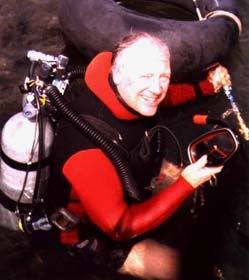DarthWader,
The "horse collar" originated as the "Mae West" during WWII for fliers and others on the water. It was a "life vest" and designed to keep a person head-up in the water during an emergency. As the double hose regulators were coming toward an end, we (I had a part in it) were defining a different problem of buoyancy compensation. Divers, particularly in cold water, used primarily a wet suit, and as we went deeper, the wet suits buoyancy decreased as the closed cell bubbles were crushed by the water pressure. We needed something to "compensate" for this buoyancy loss. We came up with many ideas. The worst of these, in my opinion, was what we currently have with a jacket mounted to the the scuba. Why the worst? Because it is mounted on the scuba. Take off the scuba tank, and loose your buoyancy. This has led to more than a few fatal accidents.
Newer designs, where the weights and the buoyance are both contained on the scuba, are much better in this reguard, as ditching the scuba does not leave the diver with weights on and no buoyancy. This, by the way, is not a problem if the diver has weighted him/herself to be neutral at the surface (a vintage diving technique). But many of today's divers are over-weighted at the surface, and so can become very negatively buoyant if the BC is removed, unless that weight also comes off with the scuba.
Concerning the J-valve, the lack of a SPG was by design early, very early. Cousteau and Gagnan, in their original patent stated that they had developed a three-cylinder scuba, with one in reserve in order not to depend upon a guage. The J-valve was an American invention, which gave about a five minute reserve on a single 71.2 cubic foot tank, simpy by tripping the lever (pulling the rod). It can be inadvertently tripped because of its orientation, and later on was reversed so that bumping it could not trip it. With double tanks, we reversed the valve so that the lever was facing forward, as is shown in this photo from the US Navy:
I have done that on my doubles:
Here is a single tank reserve from Scubapro which on which the diver could reverse the lever, making it pretty much immune to the inadvertent tripping problem:
There was another way of dealing with the reserve problem, and that was using a "restrictor orifice." This was a much smaller hole in the regulator (or vave) that, at lower tank pressure, made breathing much harder. It gave you a notice that you are getting low on air. With a single stage regulator, the breathing resistence is noticibly less at low tank pressure. This design countered that, and gave the diver a "signal" that it was time to surface. Here is a regulator with an internal restrictor reserve:
By the way, this is the "military harness," which I've modified a bit for my own BC design. The regulator is the original Healthways Scuba regulator. They later came out with a Healthways Scuba Deluxe and Gold Label Healthways Scuba, and you could order the latter with either the restrictor or a larger opening in the valve, for use with a J-valve.
Why do this, instead of look at a guage? Well, there was a lot of diving done in very poor visibility in the USA. It is no mistake that the SPG came out in California (beautiful kelp forest diving) and Florida (cave diving), where visibility was great most of the time. But in cruddy water, the SPG is useless.
Now, SPGs are required equipment, and divers don't know what a J-valve is, or how to use it.
Redundancy became very important when sport divers began diving in "overhead environments," such as cave, wreck, or extreme deep diving where decompression kept the diver from surfacing directly. It also became more important with the advent of single hose regulators, with multiple failure points from O-rings (multiple hoses, SPG, etc.). The original double hose scuba units had no O-ring seals, and so were practically immune to these kinds of catestrophic loss of air. The single stage units (USD Mistral, Heathways Scuba, etc.) had six moving parts without an O-ring seal (in truth the Healthways Scuba did have an O-ring around the seat, but this was not ameanable to failure). The USD DA Aquamaster had no O-ring seals at all. At the time, the valves were using a 1/2 inch tapered thread without an O-ring too. The sealing surface between the valve and regulator was the only real O-ring seal, and this one would typically fail upon turing on the air, not during a dive. So redundency was not a real factor in early diving.
SeaRat
 I do want to dive this reg in its proper "context" though but I can't get away from the obvious lack of redundancy. do folks typically dive with a pony back up?
I do want to dive this reg in its proper "context" though but I can't get away from the obvious lack of redundancy. do folks typically dive with a pony back up?






